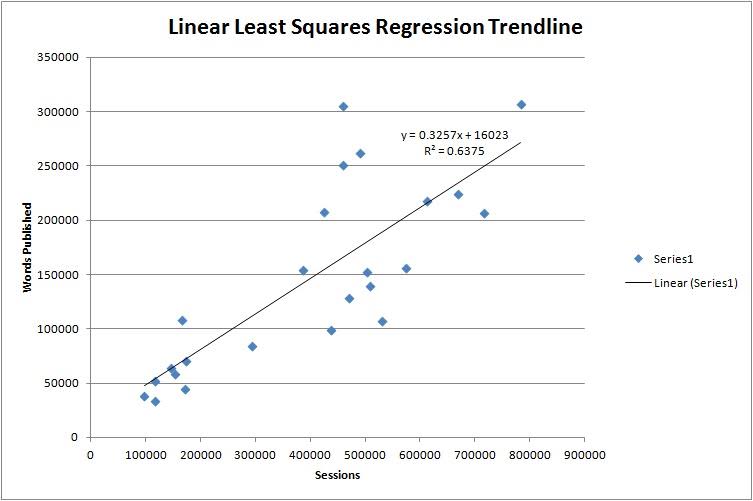Sometimes SEO is like playing whack-a-mole.
Podcast version:
SEO traffic has its ups and downs. You make some progress, ramp up what’s working only to encounter another setback.
You recover from the setback, make progress, BAM, another problem.
But over time, if you play your cards right and have a little luck on your side, overall traffic grows.
One thing is certain though.
You need some content in order to get SEO traffic.
It didn’t take me long to realize how important content is.
Except my brain went “if some content is good, mountains of it is better.””
Similarly, links are good for SEO traffic so some people figure if some links are good, hundreds or thousands is better.
The thing is more content, if done right, usually leads to more traffic.
Same with links – more quality links gets more traffic.
The question I want to assess is just how effective is publishing more and more content at getting more search traffic.
I decided to analyze 2 years of content production for my biggest site and compare it to traffic growth to see if there is a strong correlation.
Background info
- Site launch date: Feb. 2014.
- Backlinks: I did no proactive link building to this site except for a frew guest posts here and there.
- Total number of published articles as of July 3, 2019: 3,410
- Average word count of the content: 2,840 words
- Content sources: Me (as in I wrote it), many content agencies, freelancers and niche experts as well as some guest posts I accepted and published. These days I get most content from this content agency.
- Domain rating (Ahrefs): 65
- Domain Authority (Moz): 60
Content and traffic growth correlation chart
For this analysis, I noted down the number of organic search sessions for each month as reported in Google Analytics. In another spreadsheet column I noted down how many words were published on the site for each month. I then created the following correlation line chart.
Here’s the coefficient correlation chart which was generously provided to me by a reader who created it from the data table below. Here’s his email:
Just thought I’d send you the line of best fit, and correlation coefficient (R-squared). Pretty good. R-squared = 0.6375 (obvs. 1.0 being perfect correlation and 0.0 being not at all correlated).
Wow! I was very surprised at the strong correlation between the volume of content published and search traffic. I expected some correlation, but my data reveals a very strong correlation.
Here’s the table data month-by-month
For you data hounds, here’s all the data plus more in a table.
| Month | Google Search Sessions | # Words Published | # Articles Published | Avg Word Count |
|---|---|---|---|---|
| July 2017 | 166,609 | 108,178 | 61 | 1,773 |
| August 2017 | 153,075 | 58,559 | 48 | 1,220 |
| September 2017 | 97,676 | 37,984 | 45 | 844 |
| October 2017 | 116,440 | 33,370 | 28 | 1,192 |
| November 2017 | 146,607 | 64,278 | 24 | 2,678 |
| December 2017 | 117,208 | 51,837 | 23 | 2,254 |
| January 2018 | 172,360 | 44,844 | 24 | 1,869 |
| February 2018 | 173,956 | 70,676 | 51 | 1,386 |
| March 2018 | 293,954 | 83,706 | 56 | 1,495 |
| April 2018 | 386,971 | 154,261 | 116 | 1,330 |
| May 2018 | 424,233 | 207,081 | 126 | 1,644 |
| June 2018 | 460,090 | 305,011 | 138 | 2,210 |
| July 2018 | 489,892 | 261,480 | 117 | 2,235 |
| August 2018 | 459,362 | 251,026 | 110 | 2,282 |
| September 2018 | 470,116 | 128,730 | 63 | 2,043 |
| October 2018 | 531,113 | 106,736 | 65 | 1,642 |
| November 2018 | 504,025 | 152,098 | 76 | 2,001 |
| December 2018 | 438,252 | 99,082 | 44 | 2,252 |
| January 2019 | 574,590 | 155,872 | 72 | 2,165 |
| February 2019 | 508,263 | 139,681 | 75 | 1,862 |
| March 2019 | 669,932 | 223,691 | 122 | 1,834 |
| April 2019 | 717,069 | 206,292 | 117 | 1,763 |
| May 2019 | 783,527 | 306,462 | 161 | 1,903 |
| June 2019 | 611,895 | 217,253 | 116 | 1,873 |
Correlation, not causation
The best I can conclude about the above analysis is that content and traffic is strongly correlated. There are too many variables in play when it comes to SEO to say that content alone causes traffic growth. While some content is necessary, it’s not the only factor in SEO.
Observations
1. Strong correlation
Before I started collecting this data, I didn’t know what to expect. I suspected there would be some correlation between content volume and search traffic but I did not expect it to be such a strong correlation.
2. Probably not such a correlation in the beginning
My site was already a few years old by July 2017 (beginning date range of the correlation chart above). If your site is new or very young, I suspect you won’t get such a strong correlation since it takes time for sites to establish some authority.
3. Not all sites will have the same correlation
I’d be surprised if lots of sites had such a correlation. As stated above, there is more to ranking in Google than punching out content. There are many variables. Moreover, my site has considerable authority (DA, DR, etc.).
In fact, a Fatstacks forum member made the following comments about these findings which I found to be astute:
Ahh the stat geek in me oh so loves when people bring out data!
I’ve looked at this on my sites and saw the results of a test group that did a bunch of testing around the idea of more content = more traffic. The conclusion they reached was that no, it’s not a causal relationship in terms of pure volume of words/articles equaling continually increasing traffic.
My theory of what you’re seeing is it’s a case of decent quality content on a well put together site (that I would guess also has social signals and possibly visitor signals from an email list) produces ranking signals in both quality and quantity. If you could see the ranking signals, that’s where you’d find the actual causal relationship.
It’s essentially the same reason that major link builders often believe that their links are producing the traffic as they show off their success graphs. Or technical SEOs believe it’s their highly optimized pages that produce the traffic as they show off their ranking improvements based upon their on page optimizations.
Everyone has their confirmation bias but it’s really just search engine math. Produce the ranking signals better then the other sites (however you go about doing so) and the search engines will give you higher placement in the SERPS. Get high placement in the SERPS and likely get more traffic.
Or then again, I could be completely wrong…I frequently am.
Though simply from a “it’s working so who cares why” view, given what you’re seeing on that site, if I was you, I’d be seriously going all in on content publication on it.
– Splat
Does this mean I should shovel more money into content each month?
I must say I’m tempted. These days my content budget fluctuates a bit month-to-month, but overall it’s gone up over the years. I’ll continue investing more into content given the clear correlation between content volume and traffic growth.
CAUTION: The above chart and data are derived from one of my sites. That does not mean you have the same correlation so don’t just blindly shovel content onto your site. Do your own analysis and come to your own conclusion.

Jon Dykstra is a six figure niche site creator with 10+ years of experience. His willingness to openly share his wins and losses in the email newsletter he publishes has made him a go-to source of guidance and motivation for many. His popular “Niche site profits” course has helped thousands follow his footsteps in creating simple niche sites that earn big.









You are constantly deleting or de-indexing content?
No, but a good amount of the content over the last 18 months is updated.
Ah okay.The table is a little confusing. I thought it was total words published for your entire site not as additional words published for each month.
I guess, the traffic correlated also with:
1) features in google’s SERP, that appears more in your theme during these years
2) global season trends: summer – fewer users on the internet, autumn – more
3) new content – new social signals, shares, a spike of non-organic traffic
4) how your website growing relatively your biggest competitors (you grow faster then they are or slower)
By the way, I’m just thinking out loud! Good job and a good idea to measure the correlation!